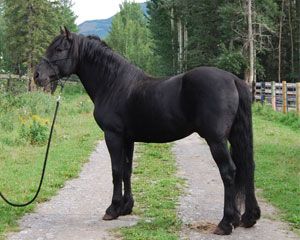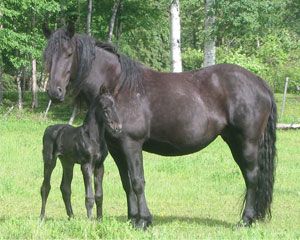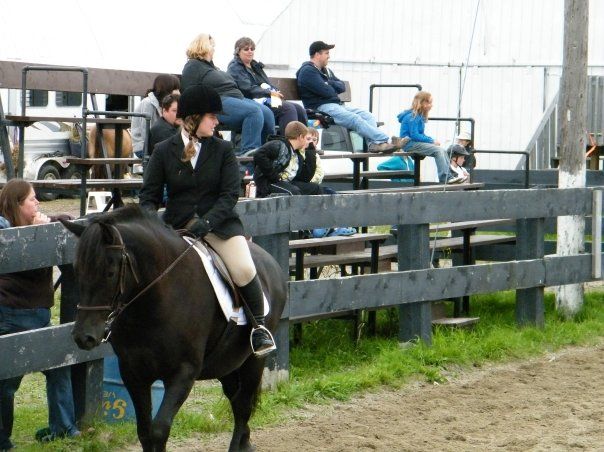Post by Shelly on Jan 10, 2015 20:17:54 GMT
I was inspired by Lip's post about the Croatian Posavac horse to do a description of the Canadian horse
Canadian horse description
The ideal Canadian horse should have a short, straight, rectangular head, set high with a small mouth and a large, flat forehead. The neck should be almost straight with well-muscled sides. The Canadian has a long, full mane and tail, slightly low withers, and a wide chest. The back should be short and straight.
Canadian horse color
Most Canadian Horses are black, with bay, chestnut or brown being less common. There are a very few individuals that carry the cream gene and are called "ash white."
Canadian horse size and weight
Their height ranges on average from 14.3 to 16.2 hands
Weight can be between 1000–1400 lbs (450 - 640kg)
Canadian horse temperament
The Canadian shows intelligence, spirit, and no excess of nervousness. The animal is generally very easy to handle.
Canadian horse life expectancy
Over 20 years
Canadian horse origin and history
The Canadian Horse descended from the French stock Louis XIV sent to Canada in the late 17th century. His goal was to develop a breeding program in the colony, and two stallions and 12 mares were sent in 1665. More shipments arrived until 1671, bringing the total number of horses to around 82. The exact origins of all the horses are unknown, with many believing most of the horses were of Breton and Norman descent, as well Andalusian and Arabian.
Canadian Horses cleared and worked the land, carried children to school, pulled the cutters and carriages and provided great entertainment for their masters in the form of racing. They endured many hardships - from brutally cold winters to hoards of mosquitos and flies during the summer, poor feed and long hours of work with little rest. They survived it all, but became smaller in size - thus the title: Little Iron Horse.
They gained quite a reputation for their hardiness and stamina and many stories were told of their courage and ability.
By the end of the 19th century the breed was in extreme danger of extinction. In 1886 a stud book was established to record the best of the remaining animals, and the Canadian Horse Breeders Association was formed in 1895. The breed struggled, but continued to be in danger, even with the help of government run stud farms. In 1976 there were only 383 registered Canadians. It was only through the efforts of a handful of private breeders that the Canadian started the slow climb back from the brink of extinction. Today there are associations in the Maritimes and Western Canada with several members scattered throughout the U.S. It is their hope that the Canadian is once again safely established on North American soil.
Canadian horse uses
Today, many Canadian Horses are bred as driving breed of horses. However, they also compete in a wide range of riding disciplines, and some are still used as work horses for farming. The generally good temperament displayed by the Canadian horse also makes them useful as all-round family horses.
Canadian horse interesting facts
Rare population status
In addition to the Beaver, the Canadian Horse is commonly seen as an animal symbol representing Canada, especially in connection with images of the Mounties. On April 30, 2002, a bill was passed into law by the Canadian Government making the Canadian Horse an official symbol of Canada.


Personal experience with a Canadian horse:
A few years ago now, I had the opportunity to work with a canadian mare named Mia. Mia was 6 years old and I broke her that summer after more or less sitting in a field her whole life. She was probably one of the easiest horses I have even broke to ride. In a summer we went from being lead while walking, to trotting and catering independently. Closer to the end of the summer we did a few shows (even placed in a senior class!), competed in mounted games and even did a little bit of cross country. Mia was so calm and collected during flats and jumping but she knew when games where set up, it was time to go! She was the type of horse that when the games where there and she was waiting to race she was rearing on the spot just waiting for me to go into my half seat to go! I never ever had to kick that horse to run games, if anything it was the opposite! I needed her to slow down so I could coordinate myself LOL.
Anyways. Since I have ridden her I have always had a soft spot for Canadian's.
Mounted games

First show

Canadian horse description
The ideal Canadian horse should have a short, straight, rectangular head, set high with a small mouth and a large, flat forehead. The neck should be almost straight with well-muscled sides. The Canadian has a long, full mane and tail, slightly low withers, and a wide chest. The back should be short and straight.
Canadian horse color
Most Canadian Horses are black, with bay, chestnut or brown being less common. There are a very few individuals that carry the cream gene and are called "ash white."
Canadian horse size and weight
Their height ranges on average from 14.3 to 16.2 hands
Weight can be between 1000–1400 lbs (450 - 640kg)
Canadian horse temperament
The Canadian shows intelligence, spirit, and no excess of nervousness. The animal is generally very easy to handle.
Canadian horse life expectancy
Over 20 years
Canadian horse origin and history
The Canadian Horse descended from the French stock Louis XIV sent to Canada in the late 17th century. His goal was to develop a breeding program in the colony, and two stallions and 12 mares were sent in 1665. More shipments arrived until 1671, bringing the total number of horses to around 82. The exact origins of all the horses are unknown, with many believing most of the horses were of Breton and Norman descent, as well Andalusian and Arabian.
Canadian Horses cleared and worked the land, carried children to school, pulled the cutters and carriages and provided great entertainment for their masters in the form of racing. They endured many hardships - from brutally cold winters to hoards of mosquitos and flies during the summer, poor feed and long hours of work with little rest. They survived it all, but became smaller in size - thus the title: Little Iron Horse.
They gained quite a reputation for their hardiness and stamina and many stories were told of their courage and ability.
By the end of the 19th century the breed was in extreme danger of extinction. In 1886 a stud book was established to record the best of the remaining animals, and the Canadian Horse Breeders Association was formed in 1895. The breed struggled, but continued to be in danger, even with the help of government run stud farms. In 1976 there were only 383 registered Canadians. It was only through the efforts of a handful of private breeders that the Canadian started the slow climb back from the brink of extinction. Today there are associations in the Maritimes and Western Canada with several members scattered throughout the U.S. It is their hope that the Canadian is once again safely established on North American soil.
Canadian horse uses
Today, many Canadian Horses are bred as driving breed of horses. However, they also compete in a wide range of riding disciplines, and some are still used as work horses for farming. The generally good temperament displayed by the Canadian horse also makes them useful as all-round family horses.
Canadian horse interesting facts
Rare population status
In addition to the Beaver, the Canadian Horse is commonly seen as an animal symbol representing Canada, especially in connection with images of the Mounties. On April 30, 2002, a bill was passed into law by the Canadian Government making the Canadian Horse an official symbol of Canada.


Personal experience with a Canadian horse:
A few years ago now, I had the opportunity to work with a canadian mare named Mia. Mia was 6 years old and I broke her that summer after more or less sitting in a field her whole life. She was probably one of the easiest horses I have even broke to ride. In a summer we went from being lead while walking, to trotting and catering independently. Closer to the end of the summer we did a few shows (even placed in a senior class!), competed in mounted games and even did a little bit of cross country. Mia was so calm and collected during flats and jumping but she knew when games where set up, it was time to go! She was the type of horse that when the games where there and she was waiting to race she was rearing on the spot just waiting for me to go into my half seat to go! I never ever had to kick that horse to run games, if anything it was the opposite! I needed her to slow down so I could coordinate myself LOL.
Anyways. Since I have ridden her I have always had a soft spot for Canadian's.
Mounted games

First show




